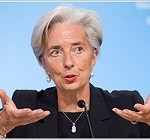Christine Lagarde International Monetary Fund (IMF) Managing Director was in India on 16 March for a two-day trip following the 11 March release of the IMF’s 2014 annual review of the Indian economy. The review has some good GDP news for India. Predictably, everybody focused mostly on the growth forecast for 2014-15 and for 2015-16 and (expectedly) missed out IMF’s reservations on a key ingredient that facilitates growth in any economy — interest rates.
There’s a bit of a story behind the IMF’s salubrious growth forecast. The original set of two IMF documents (in which Indian GDP was initially estimated to grow by 6.3% in 2014-15 and by 6.5% in 2015-16) had to be supplemented by two additional reports — one a transcript of the discussion between IMF officials and media, and, two, a copy of the IMF Survey which updated India’s growth forecast, in line with the government’s new methodology. Consequently, IMF now expects India’s GDP to grow by 7.2% during fiscal 2014-15 and by 7.5% during 2015-16.
Growth junkies celebrated this international endorsement for India’s growth prospects. They have been hankering for a rate cut, arguing that the only thing standing between them and double-digit annual growth rates were intractably high interest rates. The Reserve Bank (RBI) has rewarded them with two rate cuts — one in January and another in early March, soon after announcement of Budget. There are now demands for more, and deeper, rate cuts.
But, if they had read the IMF report a bit more closely, they might have been disappointed. The source of frustration is an accompanying document released with the India country report — called Selected Issues (as background documentation) — which includes a chapter on monetary transmission. On the basis of an internal model, this document reckons that the two-stage transmission between a repo rate cut to bank lending rate cut, via the weighted average call money rate, takes a total of 32 months. The impact on deposit rates is faster at 23 months.
Translated, that means RBI’s repo rate cut in January 2015 is likely to result in lower bank lending rates only by September 2017. The final impact on economic output and price levels, and hence growth impetus, will take even longer to feed through the relevant economic linkages. While that does seem a bit extreme, there is no denying that there is a large, looming problem in the room that nobody wants to acknowledge: transmission problems, or crimps in the financial pipeline.
RBI’s rate actions tend to take ages to travel through the economic system before they translate into lower borrowing rates for firms and households at the other end. In short, the transmission time between RBI’s rate action and banks cutting their lending rates is inordinately long, fraught with uncertainties and resistant to any mapping or measurement. Hence, nobody knows — with any modicum of certainty — how exactly this decision travels through the system, or how long this entire process will take.
The IMF report also refutes RBI’s estimates regarding transmission time, as well as dents the central bank’s confidence of improving lags and lead times under the new monetary arrangement it has signed with the Centre. The Urjit Patel Committee had mentioned that “…monetary policy in India impacts output with a lag of about 2-3 quarters and WPI headline inflation with a lag of about 3-4 quarters and the impact persists for 8-12 quarters.”
RBI has on numerous occasions — through working papers, speeches, media interactions and committee reports — acknowledged the problem of transmission leads and lags in India’s monetary policy. Most reports agree that transmission in India works through a number of channels — interest rate, credit markets, foreign exchange rates, asset prices (such as equity or house prices), expectations (about future shocks and belief in central bank ability to counter adversity) — with the existing fiscal and monetary system acting as final arbiters of the speed of transmission.
In each of the channels mentioned above, there are speed-breakers that slow down the pace of transmission. In the interest rate channel, for example, the existence of a large informal sector with largely inelastic borrowing rates, or high interest rates charged in the microfinance sector, impede transmission of rate cuts to output and inflation. Take government borrowing. Not only does it artificially dampen interest rates, it also forcibly appropriates a fixed amount of the banking system’s lendable funds, providing banks with a disincentive to heed market signals. This is one of the things that make it difficult for an RBI repo cut to materialise as a bank lending rate cut.
The Indian financial sector is dominated by banks, with public sector bank providing the bulk of banking services. The unusually large presence of state-owned banks
Hence, in the face of the conflicting transmission time periods provided by IMF and RBI, as well as the existence of innumerable structural road bumps that hinder smooth diffusion of monetary policy, there are legitimate questions about the efficacy of the monetary policy arrangement between RBI and the government.
Rajrishi Singhal is Senior Geoeconomics Fellow, Gateway House. He has been a senior business journalist, and Executive Editor, The Economic Times, and served as Head, Policy and Research, at a private sector bank.
This article originally appeared on The Hindu Businessline, here.
You can read more Gateway House content here.
For interview requests with the author, or for permission to republish, please contact outreach@gatewayhouse.in.
© Copyright 2015 Gateway House: Indian Council on Global Relations. All rights reserved. Any unauthorized copying or reproduction is strictly prohibited


